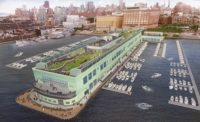"We had to think of this as a 70-year project in which the initial construction never really was complete," says Shepard. "Along the way all sorts of compromises were made, and now you had an unusual circumstance of a highway [underneath] parkland. So, we had to open up the old engine and put all the parts back together." Engine parts that were removed included the parking garage at the north end of the park grounds, a five-way traffic intersection and various road sections. "That was painful, but it opened up everything," says Shepard. "It solved traffic problems, and allowed us to redevelop and build the land bridge and pedestrian crossings." The parking garage acted as a physical barrier between tourists and downtown St. Louis, says McClure. "People would park their cars there, visit the arch, and never set foot in downtown," he says.
The parking garage has been demolished in a $10-million contract to replace it with a seven-acre park. Containing a garden, amphitheater and paths, the North Gateway will connect to the Eads Bridge and a riverside landing area as well as encourage arch visitors to continue into the city, says Boyle.
KCI Construction Co.is almost finished with a $26-million contract to build the Park Over the Highway-a 300-ft-wide pedestrian bridge that will directly connect park visitors to downtown. The MoDOT project also eliminates three overpasses nearing the end of their useful lives, installs a new vehicular overpass and revamps an existing bridge into a pedestrian crossing, says Greg Horn, MoDOT district engineer. Topping the structure with 3 ft of soil plus 5 ft of geofoam and creating a pedestrian plaza while taking bridge loads and deflections into consideration was a rare challenge for landscape architects, says James Smith, MVVA senior associate. "MODOT surprised us with their willingness to participate and engage on the project. That was very energizing."
The Park Over the Highway, with some 8 ft of fill and extensive landscaping, will hardly look like a bridge, Horn says. "The people using it won't even know there's a highway running beneath it."
MoDOT contributed value-engineered savings from the bridge program to the Great Rivers Greenway for the riverfront elevation, and coordinated with MVVA on the landscaping for the park over the highway, notes Horn. "We don't usually work with landscape architects, but we did it here to do the right design that was cost- effective yet had the right look," Horn says.
In turn, Shepard notes that, for the first 18 months, landscape architects "put on transportation planning hats. We had to test how far we could go in taking out pieces of Memorial Drive. We saw that that the new Mississippi River Bridge crossing, a mile north, was an agent that allowed wiggle room since its mission was to relieve congestion at our site. We did all sorts of work that included levels of involvement in places one block, two blocks, half a mile away."
As the bridge portion wraps up-in time for the 50th anniversary of the last segment placed for the arch monument in October-McCarthy is moving forward on a $96-million contract to build a 45,000-sq-ft extension of the existing museum. The job will require some 65,000 cu yd of excavation, says Boyle. Other major work includes some $27 million to replace the majority of 1,800 trees, retaining 610 trees and adding 3,415 new trees for a total of 4,025 total new trees. The existing ash trees will be replaced with London plane trees, and ponds and new sloping approaches to the monument from the riverfront will complement the existing stone stairs approach.
Another crucial piece involves elevating 1.5 miles of land along the Mississippi River by as high as 3 ft. This $33-million effort will eliminate up to 70% of annual flooding events that close down the riverfront, says Emma Klues, Great Rivers Greenway spokeswoman. A report found that, between 2012 and 2015, there were 104 flood days. "Once this work is complete later this year, it will be more like 30 days" over three years, she says. New roads and paths, overlooks and lighting will highlight the strip as "the front door to the region," she says.



_ENRreadyCover.jpg?height=200&t=1646347837&width=200)
Post a comment to this article
Report Abusive Comment